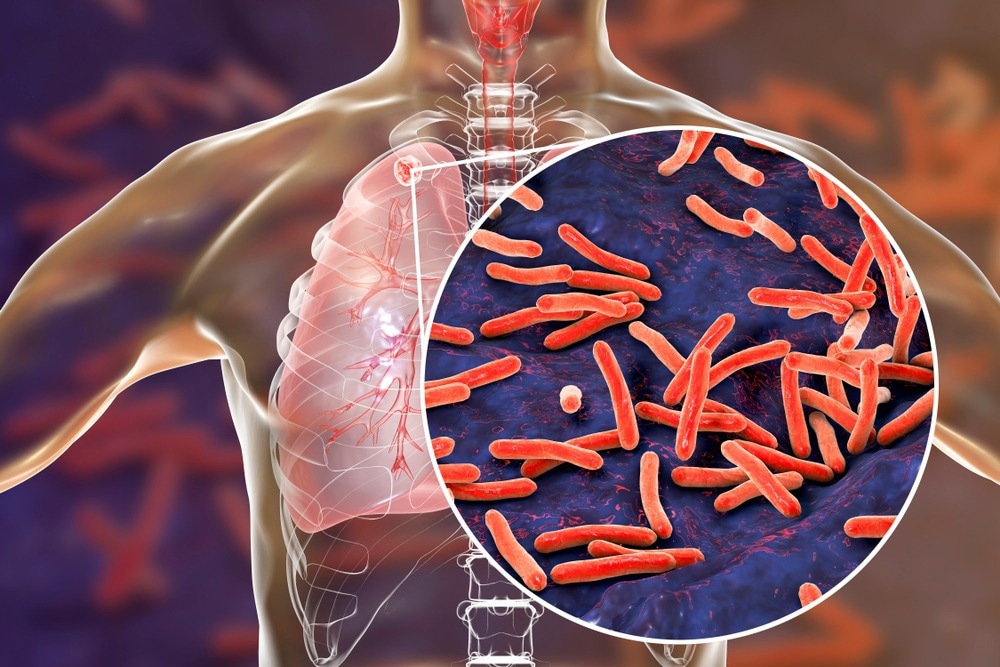Tuberculosis (TB) is a bacterial illness transferred by breathing small droplets from an infected person's coughs or sneezes. It mainly affects the lungs, although it may also affect the stomach, glands, bones, and brain system. Silver seaweed nanoparticles have outstanding antibacterial characteristics, making them great tuberculosis control alternatives.

Study: Silver nanoparticles synthesized from the seaweed Sargassum polycystum and screening for their biological potential. Image Credit: Kateryna Kon/Shutterstock.com
A recent study published in the journal Scientific Reports focuses on the antibacterial capabilities of a Sargassum polycystum algae extract and a unique green synthesis approach for creating well-defined silver seaweed nanoparticles.
Tuberculosis: Overview and Control
Tuberculosis (TB) is an aggressive illness and is among the top ten causes of mortality worldwide. Mycobacterium tuberculosis (MTB) is a tuberculosis-causing bacterium that impacts the lungs and other organs of the body except for the nails and hair. These germs pass from person to person in small droplets sprayed into the air by coughing and sneezing. Coughing, temperature, excessive sweating, and weight loss are the most common symptoms of tuberculosis.
Tuberculosis is the leading cause of death and sickness in many middle- and low-income nations. In many locations, multidrug-resistant and widely-resistant microorganisms pose considerable hurdles to successful tuberculosis management. As a result of the recent increase of multidrug-resistant (MDR) bacteria, novel antimicrobial drugs for successful tuberculosis control are now being developed.
Antimicrobial Properties of Biosynthesized Silver Nanoparticles
Biologically synthesized silver nanoparticles are low-cost, environmentally friendly biodegradable agents with several biomedical and pharmacological applications. Enzymes, terpenoids, and aromatic chemicals found in organisms such as fungi, bacteria, and seaweed, as well as plant extracts, may be employed as binders and stabilizing agents during the biological production of these nanoparticles.
Because of their tiny size and large surface area, silver nanoparticles offer broad-spectrum, robust antibacterial action against many pathogens. Silver nanoparticles can successfully eliminate microbial and viral microorganisms such as E. coli, Staphylococcus aureus, HIV, and the hepatitis B virus (HBV) in small amounts.
Silver nanoparticles negate the surface electrical charges of the bacterial membrane and modify its porosity, resulting in bacterial demise. Furthermore, the generation of reactive oxygen species (ROS) weakens the antioxidant defense system and structurally tears down the cell membrane.
As a result, the researchers are presently looking for new well-activated materials for nanoparticle production that has minimal adverse effects on human health and the environment. The production of environmentally benign nanoparticles is also urgently required to replace harmful compounds in various biomedical applications.
Seaweed Nanoparticles: The Future of Antimicrobial Agents
Marine sources are now being thoroughly studied for anticancer and antibacterial treatment options due to their comparatively mild side effects.
Seaweeds are utilized as raw materials for a variety of industrial products, although they are not often used for nanoparticle biogenesis. As a result, there are just a few studies available on the production of silver seaweed nanoparticles.
Despite this, seaweed nanoparticles can potentially treat a wide range of disorders caused by both common and multidrug-resistant bacteria. More than 841 seaweeds from the Indian coast have been shown to be effective antimicrobial agents.
Chemical approaches for producing seaweed nanoparticles may have negative consequences for human beings and the ecosystem. As a result, the development of a simple biological technique for the synthesis of silver seaweed nanoparticles is critical.
Highlights and Key Developments of the Current Study
In this study, the researchers used the biological synthesis approach to analyze Sargassum polycystum aquatic extract to produce silver seaweed nanoparticles. Various spectroscopic methods, including absorption spectrophotometer (UV-VIS), scanning electron Microscope (SEM), and Fourier transforms infrared spectroscopy (FTIR), were applied to characterize the silver seaweed nanoparticles.
The antibacterial effects of seaweed nanoparticles against several microbial infections, including tuberculosis, were investigated. Zebrafish larvae were used to test the toxicity of the produced silver seaweed nanoparticles.
The researchers utilized five different silver seaweed nanoparticle doses ranging from 5mg to 25mg. Among them, 5 mg of Sargassum polycystum silver seaweed nanoparticles were shown to be less harmful in zebrafish larvae. The silver seaweed nanoparticles from the encapsulated aqueous solution of Sargassum polycystum showed considerable antibacterial activity against tuberculosis-causing microorganisms.
The current results show that these seaweed nanoparticles have significant resistive potential against pathogens at low concentrations, making them a strong source of antibacterial and anti-tuberculosis drugs.
Reference
Thiurunavukkarau, R. et al. (2022). Silver nanoparticles synthesized from the seaweed Sargassum polycystum and screening for their biological potential. Scientific Reports. Available at: https://www.nature.com/articles/s41598-022-18379-2
Disclaimer: The views expressed here are those of the author expressed in their private capacity and do not necessarily represent the views of AZoM.com Limited T/A AZoNetwork the owner and operator of this website. This disclaimer forms part of the Terms and conditions of use of this website.